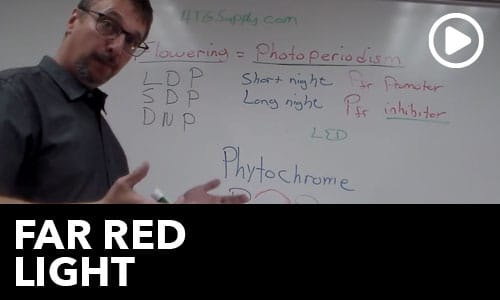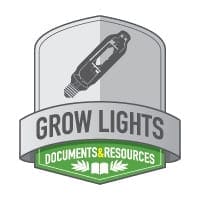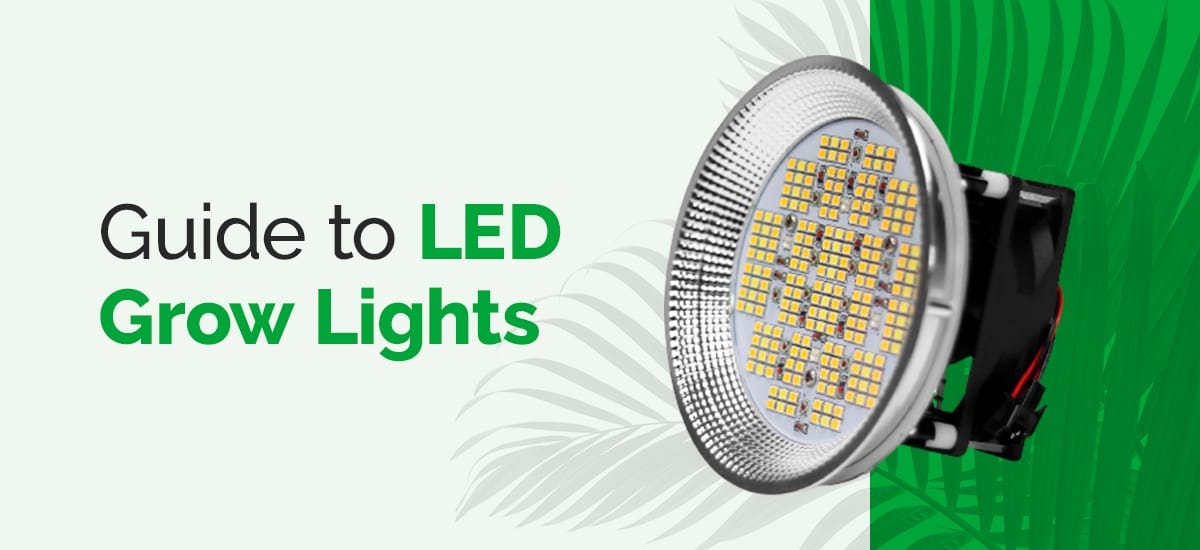Light is absolutely the most important factor to consider when growing indoors, and arguably the most complex. Understanding the actual capabilities of grow lights involves accounting for a number of acronymous specifications that can seem like hieroglyphics, even to seasoned growers. In this segment, we’re deciphering the ‘language of light’. We’ll cover the meaning of grow light metrics, and how they actually relate to your indoor garden. Plus, take advantage of the featured coupon code for special savings!
Measuring Light for Plants vs. Light for Humans
So, why are horticultural lighting measurements so complicated? The first thing to understand is that plants use light in a completely different manner than we sense it. This means some of the most common measurements listed for lighting won’t even apply to plants!
Lumens & LUX – Lumens or LUX are metrics that allow us to quantify how bright a light source is to the human eye based on our sensitivity to the Visible Spectrum. It just so happens though, that the light absorbing pigments in the human eye are most sensitive to light that plant pigments absorb least. For instance, if we said we have an LED that produces 150,000 lumens, then this LED is obviously incredibly bright. Therefore, it must be a fantastic grow light. Right? Well, what if we told you the panel has only 550nm diodes? That would mean the LED only produces green light, which the plants would actually reflect rather than absorb. Although any such LED grow lightswould be an incredibly bright light to the human eye, they would not be conducive for plant growth at all.
That’s right friend – your lightbulb there may look super bright to you, but it could be almost entirely ineffective for growing plants. Basing your grow light selection on lumens alone isn’t necessarily a bright idea, but before we jump into explaining terms and acronyms like Kelvin, PAR, PPF, PPFD and PBAR we need to understand a couple more things. When we look at measuring light for plants we have to look at it in at least two different ways. We want to know the spectrum of light is being emitted and we want to know the intensity that is being put out by the light. Let’s take a closer look at the frequently used terms for describing horticultural lighting.
Grow Light Spectrum Measurements
Let’s start with the terms and measurements we use for spectrum. Technically, colors are just wavelengths of energy we call visible light which we see and plants use for photosynthesis. The colors of the rainbow (R•O•Y•G•B•I•V) are different wavelengths that range in size from 400nm (violet) to 700nm (red) roughly. While nanometers can tell us specific colors, many grow lights produce white light, which is made up of a wide range of different wavelengths. Many growers know the light needed to make plants grow is mostly red and blue light. So how do we measure the spectrum output of white lights?
Grow Light Spectrums
K = Kelvin / Color Temperature: Kelvin is one way to measure white light spectral output, but it isn’t technically a measurement of light energy at all. Much like Fahrenheit and Celsius, this is a metric of temperature. Over the years, Kelvin has been adopted by the lighting industry to describe what is referred to as the “color temperature” or hue of a white light source. Color Temperature is based on the rule that a filament or radiator will emit different colors of light depending on the temperature of said filament. The hue shifts from red at lower temperatures to orange, then yellow, then blue.
CCT = Correlated Color Temperature: Many lamps generate light by means other than a filament, which creates light with slightly different. In this case, the actual metric used is CCT or correlated color temperature. A common example of CCT is seen when describing fluorescent T5 bulbs, but this has been used to describe the visual spectrum of high pressure sodium lights and LED’s as well. Lamps marketed as 4000K and lower will emit more red light, lamps which will be good for flowering plants and lights rated 7000K and above emit more of a blue spectrum which will be good for seedlings and vegetative growth. Lamps with a Kelvin between 5500-6500 will emit the closest spectrum to natural daylight. It’s important to note that color temperature, CCT and Kelvin only refer to the visual spectrum emitted from a lamp.
Grow Light Intensity
Now that we’ve covered how to interpret grow light spectrum, the second set of specifications we need to focus on deals with grow light intensity. This is where things start to get a bit more complicated. Let’s check in with our favorite plant biologist, Dr. Myers, for an overview intensity measurements for horticultural lighting. Then we’ll break down each measurement in further detail.
PAR = Photosynthetically Active Radiation: Light that is available to plants is measured in PAR, which stands for photosynthetic active radiation. The acronym PAR represents the wavelengths of the visible spectrum between 400nm-700nm which are the main drivers for photosynthesis. Remember our discussion above? The graph below illustrates the difference between the human eye and photosynthetic response. Notice how the curve is essentially opposite, with photosynthetic response peaking between 400nm-700nm (PAR). So, more PAR is good for plants, but how do we know how much light energy is available to plants? In order to understand how much light we’re actually providing, we need to understand PPF and PPFD.
PAR Vs Human Eye Light Sensitivity Graph
PPF = Photosynthetic Photon Flux: Photosynthetic photon flux (PPF) measures the total amount of PAR that is produced by a lighting system per second (expressed as micromoles per second – μmol/s). PPF measures all the light energy in the PAR range. This metric gives us a great idea of how much usable light a particular grow light is able to emit, but it doesn’t give us the whole picture.
PPFD = Photosynthetic Photon Flux Density: PPFD or photosynthetic photon flux density is a measurement of how much PAR is actually reaching the plant at any given time (expressed as micromoles per square meter per second – μmol/m2/s). This will help you understand how high to keep your lights above your plants. Fluorescent lights have a lower PPFD than LED or HID meaning you will need to keep fluorescents closer to plants, T-8 lights should be 1 inch from plants whereas T-5 can be 6 inches to a foot above the plants. This simple graphic below illustrates the concept. If our implied light were to be moved up, the photons would be less dense, or in other words, more spread out.
How Photosynthetic Photon Flux Density is Meaured
Measuring PPFD properly requires multiple readings taken in multiple positions. A single reading only provides a measurement from a specific location underneath a light source. For example, the PPFD in the center of a grow lights footprint will always be greater than the PPFD measured two feet from the center, assuming the vertical distance from the light was equal in both readings. Grow lights that only offer a single PPFD reading won’t give you the best idea for PAR uniformity or the realistic max coverage area the light can support. Reputable manufacturers are getting much better at releasing more detailed and comprehensive PPFD charts like the ones below that will give you readings from several different locations across a designated area. Having as many different readings as possible, both vertically and horizontally, allows for the most accurate PPFD averages.
Grow Light PPFD Charts
Pro Tip: Ideal PPFD depends on plant type and growth phase. A PPFD value of 200-400 is good for seedlings or a mother plant, and a value of 400-600 for vegetative growth and 600-900 when you are going to produce flowers/fruit. If your PPFD is 1000, light is no longer a limiting factor, and increasing your light will not give you any increased growth rates. However, if you can get your PPFD to 1000, you may want to consider supplementing with CO2, as carbon will be more limiting than light with PPFD over 1000.
PBAR = Plant Biologically Active Radiation: While not used for photosynthesis ultraviolet (UV) and infrared (IR) wavelengths of light energy are involved in photobiological reactions in plants, meaning they are important in plant growth. Notice the absorbance curves of the pigments shown in the chart below. More advanced growers should be aware of the UV and IR output of their lights. An even newer acronym that you may start reading about is PBAR, or plant biologically active radiation.
Photosynthetic Absorption Spectrum
Where PAR covers 400nm-700nm the visible light spectrum used for photosynthesis, PBAR covers 300nm-800nm which includes both UV and IR wavelengths. More and more research has been coming out speaking on the benefits of using supplemental UV for increased resin production. Most growers know that red light is needed for a good flowering response. Light in the far red range increases photochromic responses and is involved in flowering. Many studies show that when plants get 660-680 which is deep red, and 680-730 far red they show an increased flower production. Manufacturers have responded to the research and we are starting to see more and more lights including these UV and IR enhancements, as well as specialty lights such as horticultural UV grow light bulbs and far red LED strip lights, so it only makes sense that we are starting to hear more about PBAR.
Other Grow Light Specs
While we’re at it, there are a few other lighting terms that deserve honorable mentions. These measurements aren’t directly related to the quality of light grow lights produce for plant growth, but they are useful to consider for other purposes.
PAR Watts (Photon Efficiency) – This is about your wallet as well as your plants’ growth. The higher the wattage the more electricity your light will use. Theoretically, the higher the wattage the higher the PAR output should be. Another lighting term you may see from time to time is photon efficacy. This measures how efficient a grow light is at converting electrical energy into PAR. To calculate the photon efficacy of a light you can simply divide the known PPF by the input wattage of your grow light. The greater the photon efficacy, the more efficient a light is at converting energy into PAR, which means the less expensive it will be to grow plants.
Color Rendering Index – Often overemphasized in the context of horticultural lighting, CRI stands for color rendering index. This measurement quantifies a lights ability to illuminate plants or any other object reliably without color distortions in comparison to a natural and/or visually-ideal light source. Typically this is a scale from 1-100 with 100 being closest to “standardized daylight”. A light source with a CRI of 30 would be considered a heavily distorted illumination. For example, ceramic metal halide lights traditionally have very high CRI (typically 90+). A classic Tri-Band LED that favors heavy reds and blues (purple lights) have very poor CRI ratings that are often below 50.
Color Rendering Index Rating Comparison
Color Rendering Index does not really affect your plant growth, but something you should be aware of is that you may find that identifying plant health issues like toxicities and deficiencies under the LED to be difficult because you won’t be able to see the ‘true’ colors of the symptoms. HPS lamps are another popular light source that traditionally has a poor CRI. Some simple solutions for working with lights that have poor CRI would be to use color-correcting grow room glasses or add a standard light source to use when you’re inspecting the plants for problems.
Daily Light Integral – DLI, or daily light integral which is a measurement of the total amount of usable light that reaches a plant every day. This is something that greenhouse growers are concerned with since the amount of light they get each day is weather dependent. For indoors, if you are using a grow light only, you will know the output of your light every day and PPFD is all you need to know. The DLI is a cumulative measurement of all the photons that reached the plants’ canopy over the course of the 24 hour day. This is expressed as moles per square meter per day (mol/m2/d). A simple analogy – Think of DLI as the total amount of snowfall after a blizzard as opposed to how fast the snow was accumulating (which would be PPFD in this analogy). Like PPFD, DLI is a spot measurement, so it is important to take multiple readings from several different locations within a coverage area.
Now that you’re fluent in grow light lingo, you know that you want to have as much PAR as possible, which you should look for in the form of PPFD. To account for UV and IR, you will want to also know PBAR. Realize this is a measure of light quantity, not quality. You will also want to know what parts of the PAR or PBAR spectrum are being given to your plants as indicated by Kelvin or the spectral information provided. Thanks again for joining us for a light conversation, and good growing!
____________________
Tips or info to share? Join the conversation, and comment below! Don’t forget to check out this week’s coupon code and sale information as well! From all of us here, good luck, stay safe, and Happy Growing!
THIS WEEK’S COUPON CODE: LIGHTLINGO418
Enter the promo code at checkout for a 10% discount on any grow light bulb in stock! Visit your local HTG Supply and simply mention this article to get the deal in-store as well! Thanks again for tuning into Talking Shop with HTG Supply! Offer valid through HTGSupply.com and in-store 04/20/18-05/05/18. Cannot be combined with other offers. Follow us on social media for all the Sales, Events and Customer Appreciation Days. In addition, learn more about indoor growing and get all kinds of tips, tricks and techniques!



